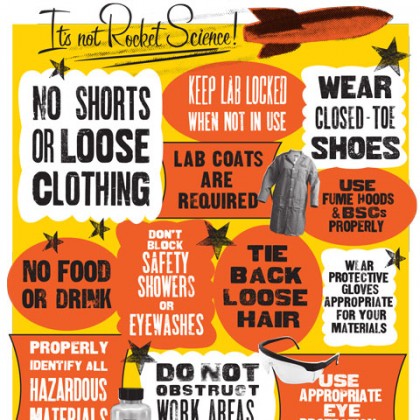Remember those eye-popping posters with the neon colors and bold type that promoted 1960s and 1970s concerts of such music greats as James Brown, Etta James, B.B. King, and Otis Redding? Well, they're back, this time to educate students about the importance of safety when working in research laboratories.

Image caption: Hard to ignore: The eye-popping posters in JHU's Krieger and Whiting school labs were created by MICA students in a style made famous by Baltimore's now-defunct Globe Poster Printing Corp.
In an innovative partnership, Johns Hopkins and the Maryland Institute College of Art have teamed up to produce a lab safety poster in the style made famous by Globe Poster Printing Corp., the now-defunct Baltimore company that produced those colorful concert advertisements. After the Cicero family closed Globe in 2010, MICA acquired many of the company's assets, creating the Globe Collection and Press at MICA. MICA is the new home for the tools used to create the vivid posters, such as more than 100,000 pieces of wood type and boxes of hand-carved illustrations and photo cuts of the many musicians who appeared on Globe posters.
The collaboration was a natural one for the two schools. While Johns Hopkins was looking for a catchy way to remind students about the importance of lab safety, MICA was working to integrate the historic collection into its curriculum. The two institutions joined forces, with Johns Hopkins safety experts providing a list of dos and don'ts for students working in labs and MICA students designing the letterpress and screen-printed poster that screams "Lab Safety—It's Not Rocket Science."
"This partnership allowed us to look at a matter we take very seriously in a positive, fun, and creative way," says Nick Jones, the Benjamin T. Rome Dean of Johns Hopkins' Whiting School of Engineering. "We tapped talent and resources from diverse and unexpected places and added a dose of good old-fashioned rock 'n' roll."
Ray Allen, MICA vice president for academic affairs and provost, says, "This was an absolutely win-win project. MICA students used the iconic graphic language of the Globe to both leaven and call attention to a very serious subject. The project is a splendid example of what can happen when we combine the complementary talents of our two great institutions."
The poster will appear in labs for both the Krieger School of Arts and Sciences and the Whiting School of Engineering this fall, and will feature the bold wood type and bright backgrounds that once enticed followers of the Godfather of Soul and Aretha Franklin to concerts up and down the East Coast.
The poster reminds students to wear closed-toe shoes, tie back loose hair, wear safety goggles, and follow nine other basic rules when working in labs. Before this campaign, the Homewood campus didn't have an official, unified lab safety poster effort.
The poster was designed by MICA graphic design students during a spring letterpress course taught by Bob Cicero, one of the former owners of Globe, who is now teaching a new generation the craft of letterpress printing and poster making. Cicero and MICA instructor Mary Mashburn, who led the charge to bring Globe's assets to the school, worked with the students to combine hand-set type and original lettering and design into an eye-catching poster. Although the neon orange and yellow layers were screen-printed commercially because of the quantity of the posters, MICA students and recent graduates gathered during the summer to letterpress print the final crucial black layer, running each of the 400 posters by hand on vintage presses in the MICA letterpress studio.
"At Globe, the challenge was always to make sure every musician got good billing, and this time the goal was to make sure each safety rule stood out," Cicero says. "I think the students really nailed that, pairing elements of Globe style with their own design work to create an eye-catching poster."
The collaboration with Johns Hopkins is a first step in MICA's goal of utilizing the Globe tools for teaching and real-world collaborations that will keep the art and craft of the iconic company alive, as well as giving it a new spin for the future.
"We are incredibly fortunate to have MICA as our academic neighbor and partner," says Katherine Newman, dean of the Krieger School. "This partnership is a wonderful example of what two terrific institutions can bring to the same creative table."
Posted in Arts+Culture, University News
Tagged graphic design, safety







